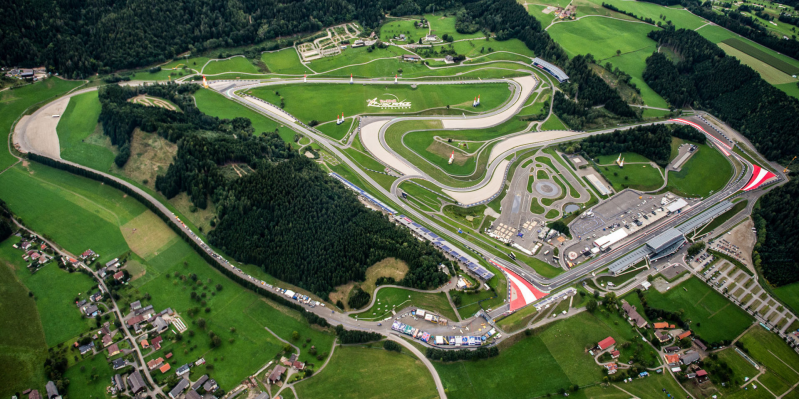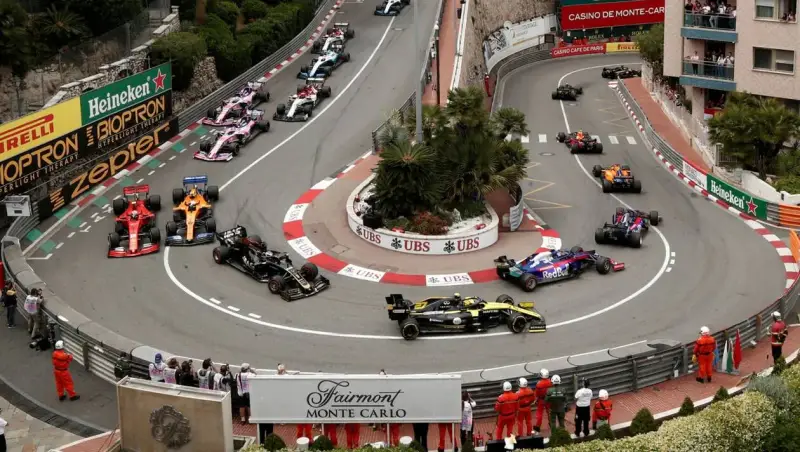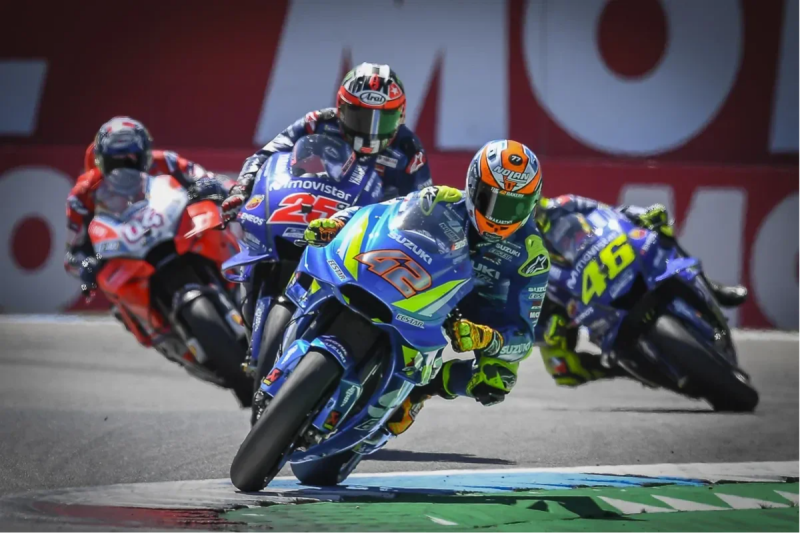There's no doubt the chaos in the FIA stewards room for the 2023 Austrian Grand Prix caused an inundation of unrest through disobeying track limits mainly around Turns 9 and 10. After racking up a total of 100 seconds of penalties applied to all drivers once the checkered flag had been waved, no wonder fans at the circuit were disappointed to say the least about the outcome which arguably didn't demonstrate the expectations of good 'on-track action.' Formula One and the FIA were at risk of an all-out war. However, this was quickly subdued by the new addition of gravel traps scattered around most of the circuit corners for 2024.
As much of a lightbulb moment this would be for the Formula One World Championship, it seems the Red Bull Ring would forget that they aren't just famous for their four-wheeled racing but also their two-wheeled racing. Not only that, but did the energy drinks company, who notably hold their name on this circuit, forget they also had a sponsor in the MotoGP World Championship? A championship where gravel traps this close to corners is an absolute no-go for the agility of an 1000cc bike?
But it's all under control! The FIA noted that “while this is not a straightforward solution in relation to other series that race here, it has proved to be very effective at other corners and circuits with similar issues” (everythingf1.com) so once again, Formula One officials wave their wand and everything goes exactly their way whether consequences present themselves to others or not.
With extensive plans to remove these in the 6 weeks time they had between the two series, it begs the question as to whether this would be better used permanently as a car racing circuit or motorbike racing circuit. It contains a variety of sharp and slow corners best suited for MotoGP, but Formula One has been using the venue since the 1970s, at least 20 years prior. Putting politics aside as to who should take the bigger slice of the cake, what makes a great circuit for competitors and fans alike to enjoy? Whether or not this comes at the cost of cutting back on certain sites?

The Perfect Recipe for a Certain Type of Racing
All tracks are never created equal depending on the type of racing and what the independent goals are for each series. For example, Formula One and MotoGP are two series which compete to see just how far the constraints of engineering can go to make a prototype as quick as possible within its regulatory limits. Although, one of these machines is much larger and wider than the other as well as motorbikes being incomparable to the lap records of these cars. This is where the agility of the rider and bike when put together will become a forefront focus instead.
Formula One has always focused on providing a car that is the fastest for each of the drivers within the regulations which is most easily found on straights as a bike would in MotoGP. However with the new-ish introduction of DRS in 2011, gaining those extra advantages is crucial to building positions throughout a race.
For example in the Austria Grand Prix in 2021, Daniel Ricciardo who was racing for McLaren at the time was able to gain a heap of 6 places over the 71 lap race after starting 13th on the grid with the help of DRS into the entry of corners, for example Turn 4 on Sebastian Vettel. In a car that only finished 4th in the championship by the end of the season and on a track with the least amount of corners, it proves that DRS paired with straight-line speed is one of the important elements in overtaking; thus contributing to a thrilling fan experience. Oppositely, you have the debatable use of the historical streets of Monaco which pushes the limits of using these huge, modern cars amongst the thin track (also contributing to a less enthusiastic outcome). In 2023, the top three in qualifying didn't change by the checkered flag on Sunday, other than Charles Leclerc being moved to P4 from P3 after an infringement prior to the race start, with hardly any movement through the field other than odd individual blunders.
Equally, having a number of straights on a circuit isn't the be all and end all of a good race in Formula One. At the end of the day, corners challenge skill and precision through braking, acceleration and handling which adds a technical element through the driver's perspective and is essential for the sport to thrive as an entertainment purpose. There must to be an equilibrium between the two where corners work in situ to provide more opportunities for decent straight-line speed rather than mistaking a Formula One car for a WRC rally car as it throws itself around harsh breaking areas. Something that Circuit of the Americas has performed perfectly since its inauguration in 2012 as well as Silverstone after multiple set-up changes in order for it to remain as a permanent staple on the calendar.

On the other end of the spectrum, MotoGP prides itself on using tracks with a variation of tight and slow cornering like Mugello which would be impossible for the accommodation of a Formula One car for the long term. After all, the only race that was held here by the star-studded series was in 2020, labelled as the Tuscan Grand Prix, which incurred 8 retirements through the race with the majority of these caused through collisions. The addition of long-lap penalty areas also need to be considered for some circuits in competitive motorcycle racing, although this doesn't add any danger to car racing in this particular circumstance.
One perfect example of a great race track in this instance is the TT Assen circuit used for the Dutch Grand Prix. Most notably in 2018, this race was placed in the record books after presenting the most overtakes for a Sunday event; 100+ to be precise in the highest category. Even as the track has been edited throughout MotoGP's raw history to accommodate safety regulations, it's the ideal venue for a weekend with an extremely grippy surface and a mixture of 19 flat-out and slow speed corners to allow for the position of riders to change. The same can't be said for the Circuit Ricardo Tormo in Valencia; a track that is able to hide how little excitement it brings by filling headlines with the championship decider of 2023 between Pecco Bagnaia and Jorge Martin. At a first glance, it seems like a decent layout for bike racing, however only houses good overtaking opportunities and unpredictability for lower classes like Moto3.
Objectively, some MotoGP races perform just as well on tracks with long stretches of road in order to gain some sort of slipstream. Examples of this include Silverstone which mostly received a great reception even if it includes a 760 metre long straight in the Hangar Straight and 650 metre through the Wellington Straight. To put this into perspective, the longest straight in the TT Assen circuit is only 560 metres and even though true fans will never forget the spectacle of Donington Park, in the last 10 years, 3 of these grand prixs have been decided by under 0.150 seconds with a different rider crowned the victor in this time frame also. But who is to judge whether it is better suited for Formula One or MotoGP? They both relay very important arguments as to who should remain: Formula One producing a number of successful British drivers since its inauguration in 1950 as well as memorable overtakes and crashes through that time, and MotoGP always serving an unpredictable outcome in recent years.
Different Perspectives of 'Good Racing' - Forgotten Circuits Of Past Championships
When it comes to specific types of racing, the criteria for a racing spectacle at a track can be determined by driver and fan experience and both factors in the past have been attributed to the editing or complete removal of a circuit in these championships. So what examples have caused this?
As mentioned before, Valencia is a highly controversial circuit in terms of MotoGP however the street circuit on offer to Formula One was stamped out at its quickest opportunity. Named 'The Valencia Street Circuit', this race was only used from 2008 to 2012 after making a deal with notable Bernie Ecclestone and for good reason. The 25 cornered circuit hosted a multitude of issues through almost every turn: a short pit straight leading out directly into turn 1, drivers exit the turn 4 and 5 chicane running extremely close to the wall, turn 8 leading drivers through at only 55 miles per hour which isn't too shy of the pitlane speed limit, so forth leading through small DRS zones for its final two years and finally another very slow turn 25 hairpin. Fans and drivers alike just weren't enjoying the race and the €98.5 million price tag to rejuvenate the track just wasn't going to pay off in the long run as well as the disagreement to interchange the circuits each year for the Spanish Grand Prix. Could history repeat itself for the MotoGP track just 25 miles away?
Hockenheimring offers another reason as to why fans couldn't enjoy the racing in Formula One. Of course the original changes of the track never bothered fans that much in the 60s for the motorcycle era with its layout becoming the most prominent of this time due to Kevin Schwantz’s trailblazing pass on Wayne Rainey in 1991 whilst coming into the stadium. It's also important to note that in this particular year, Formula One would be held 2 months later so no mishaps with track construction there. However the 2 wheeled series ultimately determined that the Sachsenring was much better suited for 1998 onwards, a reasonable negotiation, and 4 years ahead of when Formula One would tighten their grip in the motorsport world. The drastic changes that were made in 2002 ensured it was never the same with almost half of the circuit removed as the famous series threatened to stop racing at their venue. Forest areas were chopped for tighter corners and at least half or all of the straights were discarded. Alternating from the Nürburgring and this circuit each year was dreamt up by Bernie Ecclestone once again from 2007 but could never come to an agreement with the rights holder. It was time to finally say goodbye as fans knew they would never enjoy the shadow of the track it once was.
Misano circuit is the one example of a track barely surviving in the case of MotoGP after Wayne Rainey's memorable crash in 1993, causing him to fall and break his back. The safety of the track was immediately compromised therefore removing itself from the calendar only until 2006 where it would return with successful major changes and renamed in 2012 to commemorate Marco Simoncelli. Formula One would never dream to even try this circuit due to its extremely tight corners and establishment of a 'primary motorbike circuit' with the exception of the newly added Formula E and GT championships. I don't think even Mr. Ecclestone could convince otherwise.
Should circuits only be allowed to hold one type of racing?
With the evolution of speed in motorsport becoming all the more relevant through the advancement of technology, there's no doubt as to why tracks are removed and added to the season calendar. These championships are the lifeblood for these circuits and need to keep up to prevent complete downfall and abandonment. That being said for the same reason, it's no surprise that tracks have had to change with the times to keep up with each other, varying as to what type of racing is better accompanied to its layout like Mugello. But should this ultimately be the case for every single track in a championship season? Should series be battling to hold their races at specific circuits?
One thing that's important to remember is the loyalty that fans have towards different categories of motorsport. A Lewis Hamilton, Lando Norris or George Russell fan can be equally as passionate for the wonder of Jake Dixon in Moto2, so being able to attend both races in their own country is more economical than applying a travelling aspect to Europe as it's assumed that Donington Park is becomes less of an option. As well as organisers working with track personnel to do all they can to preserve historic relationships with these championships.
I imagine a simple answer to 'Should tracks just pick one high-value championship to use?' would be something like, no. Tracks can't afford to lose places in the calendar so complex compromises must be made in order to keep both parties satisfied with safety and crowd turn-outs. With preparation and precision, for example splitting the championships further away in each other seasons, this allows less panic amongst organisers in order to accommodate for the two types of racing. It makes you wonder how the 2025 seasons will plan their time regarding the Austrian GP. During the 2023 season, there was also a 6 week gap between Formula One and MotoGP's rounds at the Losail circuit; something which could be evermore prevalent in further years to come depending on where the motorbike series decides to permanently position this desert race. Let's just hope that Formula One aren't planning on adding any hindering gravel traps to Qatar any time soon.




Add comment
Comments